eReference Library

An Exceptionally Nice Gurley Surveyor's Transit Circa 1880
Useful Information - Early Transits
Collecting Surveying Transits is a BLAST! Instrument makers produced an amazing number of transit varieties in rather small numbers. So you can enjoy searching for and occasionally finding different (and possibly unique) instruments for years.
The earliest transits (from 1831 to the early 1850s) were basically vernier compasses with a scope replacing the sight vanes and arms. From the early 1850s to the early 1860s , a number of instrument makers figured out ways to make transits for more useful and accurate (sometimes referred to as the pre-1862 Transits). After the early 1860s, instrument makers hit upon the popular version of the transit. They also figured out ways to add solar attachments (see the Solar Instrument webpage) or make the transit suitable for mine surveying (see the Mining Instrument webpage).
If you look thru the instrument maker catalogues, you will find Transit names like Enigineers, Surveyors, Mountain, Light Mountain, Explorers, etc. Basic transit (Engineers and Surveyors) were somewhat big and heavy (think old 7lbs laptops). The makers found ways to make the instruments smaller and lighter over time (think 3lbs laptops of today), and offered these transits at elevated prices.
For those who are not hard core surveyors, the nomenclature can be a bit daunting. Fortunately, Bud Uzes created a handy dandy nomenclature chart for you.
Railroads were the early adopters of transits. Transits were akin to a Railroad Compass with a telescope replacing the sight vanes. Check out the 1875 Engineering News article on the development of transits (discussed more below), which is written for a railroading perspective.
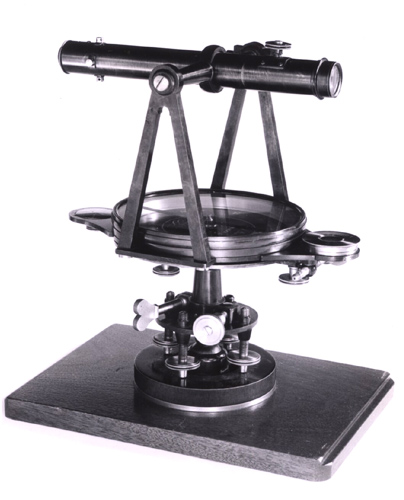
William Young invented the American Surveying Transit in 1831 - this is apparently the first, or one of the first, transits that Young built.
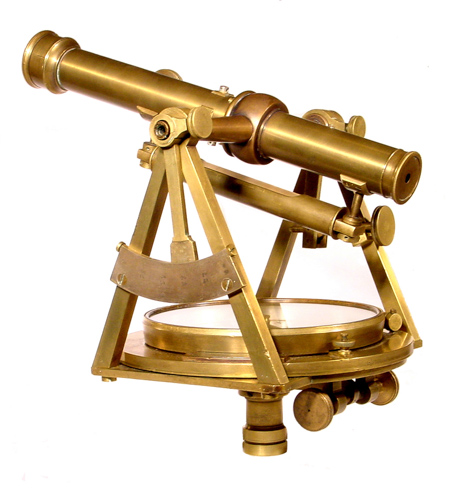
Schmolz compass circa 1858. This is a unique design of surveyor's transit known as "Pre-1862 Surveyor's Transit" and is described in Robert Miller's article in Rittenhouse, Vol. 7, Issue 28, August 1993, titled "The First Surveyor's Transits, 1852-1862." This style has the standards attached to the lower horizontal plate instead of the upper. It was intended for retracing land boundaries rather than for engineering purposes.

Gurley Transit from the 1856 Gurley Catalogue. Like the Schmolz to the left, this is a unique design of surveyor's transit known as "Pre-1862 Surveyor's Transit" and is described in Robert Miller's article in Rittenhouse, Vol. 7, Issue 28, August 1993, titled "The First Surveyor's Transits, 1852-1862." This style has the standards attached to the lower horizontal plate instead of the upper plate.
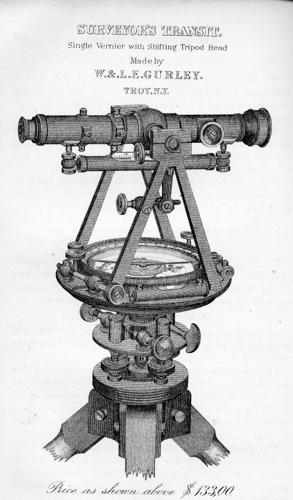
Gurley 1874 Surveyors Transit - $133. Note the straight legs on the standards - which Gurley changed circa 1885.
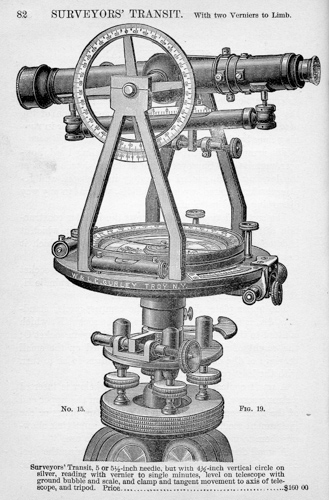
Gurley 1888 Surveyors Transit - $160 but with a few more bells and whistles. Note the bent standard legs and the spring loaded tangent screws under the compass plate.
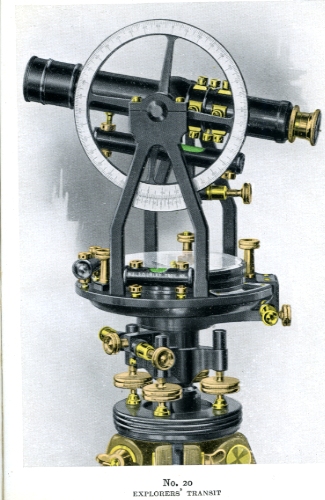
Gurley Explorer's Transit - 1910 Catalogue. Very Light and Small, and could fit inside a Gurley design and made suitcase.
Resources for Transit Collectors
Check out the first advertisement ever for a Transit - William J Young put an ad in the American Railroad Journal in March 1833.
In 1875, the Engineer News magazine published a fascinating and lengthy article about Young's invention of the transit, and the subsequent development of transits generally. The article walks thru the failings of the English Theodolite and details the great advantages of the sturdy little transits. Written by a surveyor who used early transits extensively for railroads. A great read - 1875 Engineering News Article.
Brain Aregood's 2011 book "The Complete Guide to Early W. & L. E. Gurley Transits" is a MUST-HAVE book if you want to collect Transits, especially Gurley Transits. Amazing detailed, and written in a way that even non-surveyors can easily follow the discussion. The book comes in two flavors at Amazon - Deluxe (color) for $80 and Standard (B&W) for $50. I opted for the Deluxe version - crisper illustrations. No regrets.
For a more detailed discussion of the evolution of the American Transit, you can read an article authored by Dale Beeks, which is reproduced at surveyhistory.org.
I'm still pulling together other transit resources. For now, the best place to look is in the individual maker catalogues, especially the Gurley, K&E, and Berger Catalogues.
© 2020 Russ Uzes/Contact Me